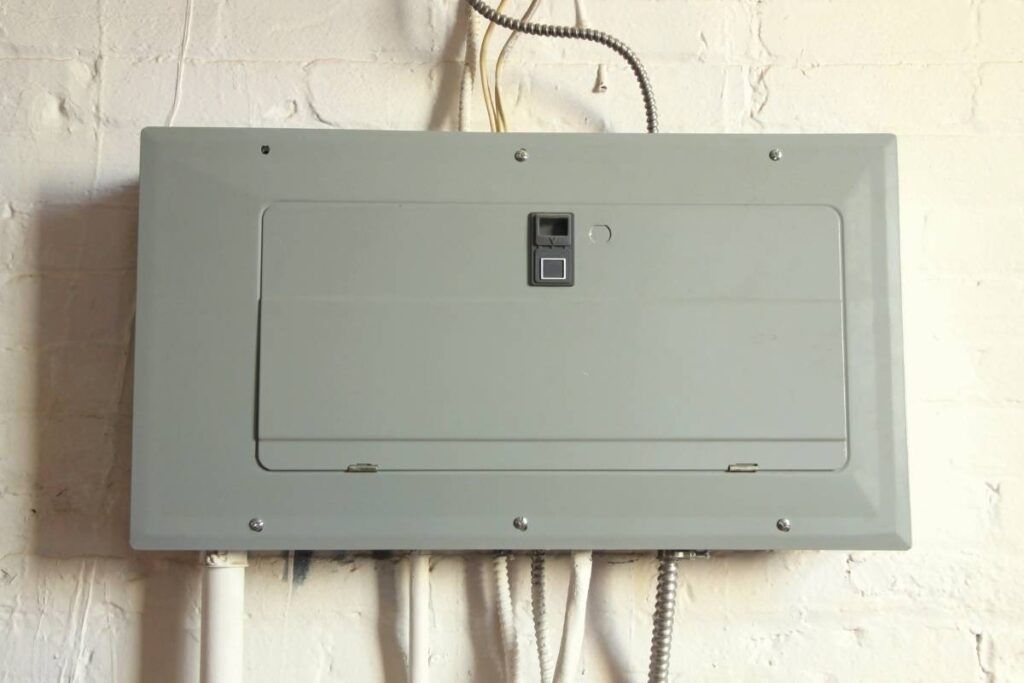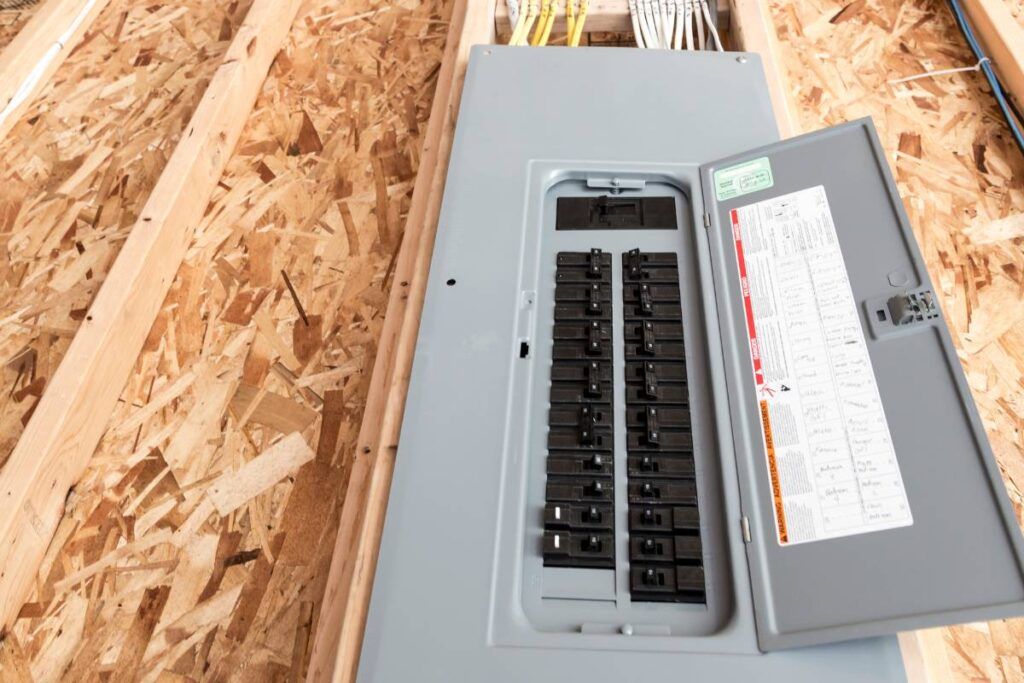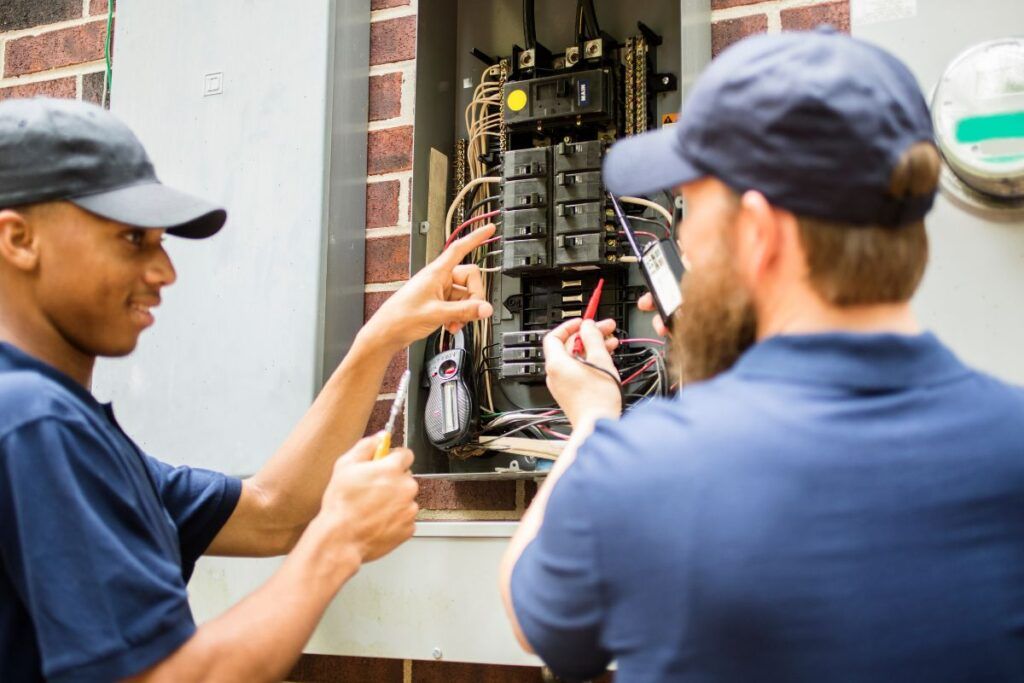Most houses use 200 amp panels due to the increased use of electrical devices. But some houses run safely with 100 amps. But the question is, can you use a 200 amp circuit breaker into a 100 amp panel? Will it be safe? Let’s find out.
You should not run a 200 amp breaker in a 100 amp panel as it can be dangerous. Even if you somehow manage to run the circuit breaker, there remains a risk of overloading and fire hazards. Since the bus bar is rated only up to 100 amps, try using lower amps or upgrade the panel if needed.
The panel’s amperage and the number of breakers to use are integral parts of the electrical system. If you have a 100 amp panel, this guide will explore the correct circuit breaker sizes for 100 amps and the possibility of running 200 amps.

Check out our list of top-handpicked products for all your electrical, appliance, and HVAC system needs to keep your home running smoothly.
This post includes some affiliate links.Introduction to the electrical services and circuit breakers
The main panel (the circuit breaker panel or the control panel) is the heart of your house’s electrical system.
The panel is a large metal box mounted into the wall near the main electrical meter, basement, utility area, or garage.
The main panel has three main jobs:
- It is the main distribution hub of all the individual breakers in the residential electrical wire system.
- It houses the breakers of the individual circuits and is considered the main over the current protection service.
- The panel also houses the main control switch to connect or disconnect the incoming power from the utility to all other branch circuits.
The breaker panel has several parts and components which play different roles:
- The main circuit breaker sits over the panel. The wires from the utility pass through the breaker and act as the disconnect switch.
- The main breaker connects to a pair of copper or aluminum strips called bus bars. Each bus bar has a HOT connection from the main breaker, which is the hot bus bar.
- Below the main breaker contains multiple breakers that control the individual branch circuits for large power circuits like water heaters, dryers, pumps, heating systems, bathrooms, kitchens, living rooms, and many more.
- The outer side of the hot bus bar has a couple of bars called the neutral or ground bus bars, which act as a return path for the current.
Some common circuit breaker sizes you use in the main panel are:
- 15 amps
- 20 amps
- 40 amps
- 50 amps
- 60 amps
- 100 amps
- 200 amps
The 15 amps and 20 amps control the individual branch circuits, and the 100 amps and 200 amps act as the main circuit breakers.
Understanding the difference between 200 amps and 100 amps main breaker

Most houses use two standard breaker panels: 100 amps and 200 amps.
There are also other amps like the 250 amps, 300 amps, and 400 amps.
But they are used when you use multiple high-powered electrical devices.
So which one is better? 100 amps or 200 amps?
Generally, a small house with a few electrical appliances will run safely at 100 amps.
According to the National Electric Code, or NEC, every house must have at least a 100 amp panel.
It is the standard amp for houses with small families and no electrical heating.
However, in a 100 amp panel, you can only use 80 amps due to the 80% rule.
But recently, people have started using multiple electronic devices that need more power for their best performances.
So, 100 amps may be insufficient for houses with heavy-duty appliances that need 220-240V circuits, like heating systems, HVAC, dryers, etc.
That is why people have started upgrading the electrical system from 100 amps to 200 amps.
A 200 amp panel is commonly used in newer houses with appliances like dryers and heaters. My house runs with 200 amps.
It can give you up to 160 amps of usage, which is relatively more than a 100 amp can provide.
Based on the technology usage level, it will become a norm to use a 300 or 400-amp service in the future.
But now, 200 amps is still better than 100 amps.
Can a 200 amp circuit breaker be used with a 100 amp panel?
A common question will strike your mind when you add a circuit breaker to a 100 amp panel – whether you can use a 200 amp circuit breaker in a 100 amp panel.
The breakers will support several other appliances’ individual circuits, for example, the HVAC, the dryer, etc.
A 100 amp panel comprises 20 circuits, which can handle 20 full-sized breakers.
20/24 panels will hold 16 full-sized and 4 twin breakers, totaling 24.
You can add any size of a breaker to the panel.
A 100-amp panel can have breakers with a total amperage capacity exceeding 200 amps.
But, it is risky to add a 200 amp breaker in a 100 amp panel. Below are a few reasons why you should avoid doing it.
Explanation of overloading
A circuit breaker should not exceed the ampacity of the panel. In that case, the main breaker will keep tripping.
A 100 amp panel will be able to handle only 100 amp ratings.
If you intend to use a 200 amp breaker in a 100 amp panel and increase the load, your main panel may overload due to excessive power draw.
Besides, the bus bars of the 100 amps are mostly rated for 100 amps only.
So, using a 200 amp panel can be dangerous.
However, the bus bars of some 100 amp panels might also be rated for higher amps.
Even with smaller bus bars, you can run the appliances without any negative results.
As long as the load does not exceed the panel capacity, you can use a 200 amp breaker in a 100 amp panel.
Comparison of circuit breaker ampacity and wire sizes

It is safe to avoid using 200 amp circuit breakers in a 100 amp panel.
The first concern is the bus bar.
As mentioned earlier, a 100-panel will have bus bars rated for 100 amps.
Using a 200 amp breaker will overload the panel.
The second concern is the wire sizes.
The 100 amp panel uses #4 AWG wire, and the 200 amps use 2/0 AWG wire.
So, if you are using a #4 AWG wire, it won’t be enough for 200 amps.
The current running the 200 amps will overheat the wire and lead to a fire hazard.
Using a thicker wire that supports both amps will solve the problem.
But, still, due to the bus bar capacity, it is better to avoid such pairing.
Factors affecting the compatibility of a 200 amp circuit breaker with a 100 amp panel
The 100 amp panels are smaller and suitable for running smaller houses with a few electrical devices.
That is why adding breakers that exceed the load can be risky.
There are a few factors that affect the compatibility of adding a 200 amp breaker with a 100 amp panel:
Load support
When you select a breaker for your panel, you should keep in mind the load.
It would be best to use a circuit breaker that does not surpass the load of the main panel.
Since it is a 100 amp panel, adding a 200A breaker will exceed the panel load.
As a result, the breaker will overheat and keep tripping.
If you have chosen a breaker that exceeds your main panel’s load, you should either exchange the breaker or upgrade your panel.
Wiring
Wire size is vital.
100 amps use 4 AWG wires, whereas 200 amps use 2 AWG wires.
So, if you wire the panel with 4 AWG, it won’t handle the current transmitted by the 200 amp.
As a result, the wire will overheat, melt, and start a fire.
Bus bars
In a 100 amp panel, the bus bars are rated for 100 amps only.
Using a 200 amp breaker will overload the bus bars.
Exceeding loads will trip the breaker constantly.
Some bus bars in the 100 amps are rated for higher amps, like 125 amps. But, rarely, any 100 amps will have a 200 amp rating.
The pairing is risky even if you sparingly transmit the 200 amps through the panel.
It is better to find out from the manufacturer manual whether the 100 amp panel can physically accommodate the 200 amp breaker and then use it.
Advantages and disadvantages of using a 200 amp circuit breaker with 100 amp panel

Unfortunately, adding a 200 amp breaker in a 100 amp panel does not have a lot of advantages.
Such a pair will be filled with demerits and risks because the load used by a 200 amp breaker will exceed the 100 amp load.
Remembering the 80% rule, you must choose a circuit breaker that is either 100 amps or lower than that.
With a 100 amp, you can use only 80 amps of the panel. So, adding 200 amps will overload the panel and lead to several trips.
One of the biggest disadvantages of making such a setting is Code Violations.
If your panel has been stamped somewhere about the 100 amp rating, you are not allowed to install a breaker beyond 100 amps.
However, you can add a 200 amp subpanel to a 100 amp panel.
That will be beneficial for your house.
A subpanel is an additional small panel that gives you more power to add a few more electrical appliances.
The subpanel feeds off of the main panel of your house.
It is mainly added when your recent electrical panel runs short of space.
A subpanel will allow you to add more breakers.
You can rewire your panel box and combine other breakers or add a subpanel for more breaker options.
Subpanels are great for adding power to a detached structure like a garage, workshop, or barn.
Alternative options
Using a 200 amp circuit breaker in a 100 amp panel is risky. You can try a few alternatives, like:
- Upgrading your main panel
- Using a breaker within 100 amps
- Changing the wire size
Upgrading the wire size

If you still do it because you do not intend to run a load that exceeds the main panel’s load, upgrade the wire.
If you have a 100 amp panel, you would be using a 4 AWG wire.
If you plan to add a 200 amp breaker in the panel, upgrade the wire to 2 AWG.
It will handle the current passing through the 200 amp breaker without overheating, wire melting, and fire.
However, I still suggest not using such a pairing.
Once, without proper knowledge, one of my friends tried doing a pairing similar to this situation and ended up with constant trips and overloading issues.
Upgrading the main panel
Upgrade your main panel from 100 amps to 200 amps.
Then, you can use a 200 amp circuit breaker in the panel.
Both the amps have the same load.
So, there will be no load exceeding and no tripping.
Using circuit breakers of 100 amps or below
Using circuit breakers within 100 amps will not exceed your panel’s rated load.
So there won’t be any overloading or tripping.
Breaker options include:
- 30 amps
- 50 amps
- 60 amps
100 amp panels are risky, which is why they are perfect for small houses with few or no high-powered appliances.
However, using multiple breakers of such amps will be troublesome because it can exceed 100 amps load.
But that sometimes works fine because you won’t use all the circuits simultaneously.
Even if you do so, you rarely cross 100 amps load because you cannot use their full capacity due to the 80% rule.
Still, there will be a risk of overloading and breaker tripping.
Safety considerations

I do not recommend using a 200 amp breaker in a 100 amp panel as it can exceed the main panel’s load and lead to overheating.
You should follow a few safety considerations while upgrading your electrical panel:
- If you use a 200 amp circuit breaker, ensure the load does not exceed the main panel’s load.
- Use thicker wires for safety purposes.
- It would be better to use the same size or smaller breakers for 100 amps, like 30A, 50A, or 60A. You may even use 100A.
- Ask your electrician about the possibility of using a 200 amp breaker in a 100 amp panel. Also, know the exact load a 100 amp should receive while using a 200 amp circuit breaker.
- You may add as many breakers as you like in your 100 amps. But ensure that it does not exceed the panel’s load. The NEC prohibits using more than 20 breakers in one electrical panel. For example, you should not add 2-3 60 amps breakers as it will exceed the 100 amps load.
- While selecting a breaker, ensure its load support. For example, do not install a 30A breaker in a 100 amp panel if the breaker load exceeds 30 amps.
- Follow the manufacturer manual and consult the panel manufacturer before you decide anything.
- Always keep the 80% rule in mind. You must leave 20% space free in the panel and use the rest. For example, in a 100 amp panel, you can use only 80 amps. Depending on this rule, you should choose the circuit breaker size.
Final thoughts
You can add any breaker size to a panel. Some people add breakers with a total amperage exceeding 200 amps in a 100 amp panel, which is unsafe. Generally, you should not use a 200 amp circuit breaker for a 100 amp panel as it exceeds the main panel’s load.
However, some people take this risk because they intend to stay within the main panel’s load, even with a 200 amp circuit breaker. Besides, if a rating stamp is printed somewhere in your 100 amp panel, installing something higher than 100 amps will lead to Code violations.
So, I would not consider the pairing to be safe. If you do so, do it at your own risk. Use a wire size meant for 200 amps so that it doesn’t lead during any accidental overloads. Other alternatives include upgrading the panel to 200 amps, using a 200 amp subpanel instead, and using circuit breakers measuring 100 amps or below, like 30A, 50A, or 60A.
How can I determine the circuit breaker size for 100 amps?
Keep the 80% rule in mind and ensure that the breaker box size should not exceed the main panel’s capacity. If your breaker exceeds the load, upgrade your panel to a greater capacity.
How much will it cost to install a circuit breaker?
It will cost around $500 to $2,000, based on the breaker size, labor charges, work challenge, and your living area. Panel upgradation costs around $1,300 to $3,000.
Reference: Electrical Panel Wikipedia; Circuit breaker box Wikipedia
